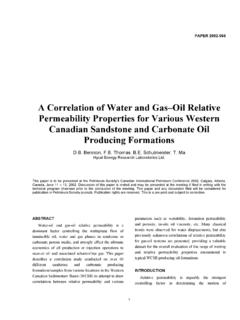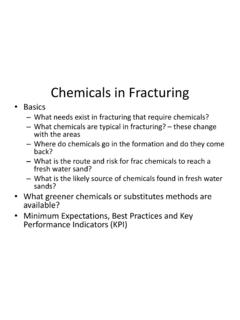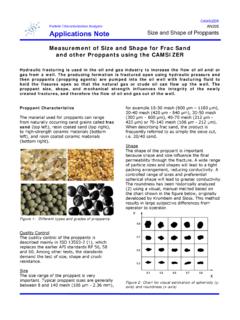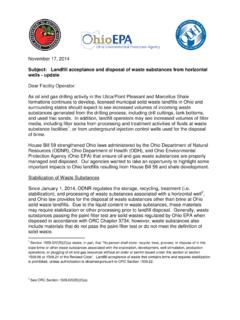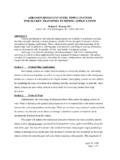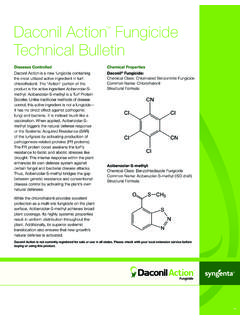Transcription of Mechanisms of Formation Damage and …
1 SPE 30320 Mechanisms of Formation Damage and permeability impairment associated With theDrilling, Completion and Production of Low API Gravity Oil Bennion, Thomas, Bennion and BietzHycal Energy Research Laboratories LtdABSTRACT9, Formation Damage issues peculiar to the drilling andcompletion of horizontal wells in heavy oil producing economic production of heavy oil reservoirs requires an in-depth understanding of the specific Mechanisms of fonnationdamage which are unique to these types of formations. Thispaper will provide a brief description of some of the dominantmechanisms of permeability impainnent which can occur in lowAPI gravity oil-producing zones. These include:This paper provides a general overview of many of the potentialtypes of fonnation Damage which drilling, production andreservoir engineers as well as geologists and geophysicists shouldbe aware of when planning exploitation programs for heavy oil reservoirs present a unique challenge to reservoir andexploitation engineers as they exhibit properties not commonlyfound in normal more conventional API gravity oil associated directly with the heavy oil such as highasphaltene (and possibly paraffm) content, extreme viscosity,solids content and a propensity to fonn stable water in oil orgas in oil heavy oil producing fonnations are contained in poorlyconsolidated or unconsolidated sandstone fonnations in manylocations in the world.
2 These particular types of formationspose their own particular challenge with respect to content ofreactive clays, potentially mobile fines, mineraltransformations and the physical problems associated withsand retention and control during nonnal induced Damage . solids entrainment. fines migration. rock/fluid incompatibilities. fluid/fluid incompatibilitiesReactive clay induced damageFormation of emulsions (water-oil, oil-water)Foamy oil phenomenaSand control and consolidation issuesCompletion induced Damage , acidizing, solvent injection, induced Formation Damage . mineral transformations. mineral and Formation dissolution. wettability alterationsBiologically induced Formation Damage issuesReferences and illustrations at end of paper2 Mechanisms OF Formation Damage & permeability impairment SPE 30320 associated WITH DRilLING, COMPLETION & PRODUCTION OFlOW API GRAVITY Oil RESERVOIRSThis paper will attempt to quantify in a brief descriptive mannermany of the common Mechanisms of Formation Damage whichshould be considered when drilling and completing heavy oilreservoirs.
3 And provide indications of potential techniques whichmay be considered to attempt to reduce or eliminate some of theconcerns associated with these particular Formation Control and Production IssuesA major problem associated with the production of heavy oilsand bitumens from many low API gravity crude oil reservoirs isthe fact that it is very difficult to produce the bitumen withoutproducing large quantities of entrained Formation fines and variety of techniques to retain sand such as pre-packed screens,openhole gravel packs, Formation consolidation treatments, fracand pack treatments, etc. have been attempted, in many situationsover the years, with varying degrees of success. Generalconsensus among operators often is that, when sand productionis significantly reduced, oil productivity also tends to besignificantly reduced.
4 A number of different authors haveinvestigated gravel packing as a technique for sand retention( ).Bennion et al(7) provides a detailed discussion of gravel packsizing criteria for the Rosary sands in the Battrum study illustrates significant reduction in gravel packpermeability and ultimate well productivity is achieved if poorgravel pack sizing is selected which allows the physical invasionof produced particulates and fines from the Formation into thegravel pack. The authors also postulated, based on results inboth Canadian and Bakersfield heavy oil producing operations,that many of the problems associated with restricted gravel packproduction may be related to near wellbore disturbance anddamage phenomena associated with problems in the originaldrilling and completion operations.
5 It was discovered that, ifinvasive Formation Damage and near wellbore disturbance couldbe minimized during the original drilling and completionoperations, near wellbore consolidation and sand controlproblems were much less problematic resulting in significantly(500%) greater productivity on the post-gravel packed wells.~AJOR Formation Damage Mechanisms INHEAVY OIL RESERVOIRS-- ---Major Formation Damage Mechanisms in heavy oil reservoirs canbe subdivided into four major classifications, these being:Mechanically induced fonnatjon damageChemjcally induced fonnation damageBiologically induced fonnation damageThennally induced fonnation of these will now be discussed in greater detailMechanically Induced Formation Damage MechanismsPhysical Mi2ration of In-Situ FinesMany heavy oil reservoirs are clastic formations which containa high concentration of potentially mobile, in-situ fmes andparticulates.
6 These could include clays such as kaolinite, detritalrock fragments, pyrobitumen or other potentially mobilematerials. Heavy oils occurring in carbonate reservoirs are alsonot immune to fines migration phenomena as documentedinstances of the migration of dolomite or carbonate fines,pyrobitumen, etc. have also been observed in this type ofreservoir Entrainment Phenomena-Figure 2 provides a schematic illustration of the mechanism ofsolids entrainment into homogeneous matrix type systems whichare commonly encountered in most heavy oil migration is controlled by a number of factors includingwettability of the porous media (fines generally tend to migratefairly exclusively in the phase that wets the rock). Thisphenomena is illustrated in Figure 1. Pore size distribution andsize of fines, as well as velocity of the fluids flowing in theinterstitial space, also strongly control the severity of problemsassociated with fmes mobilization.
7 Fines migration can becontrolled in a number of fashions in heavy oil reservoirs,ranging from reducing apparent velocity by utilization ofopenhole completions, selective fracturing jobs or, in somesituations, potentially mobile clays can be stabilized through theuse of chemical clay stabilization treatments which have beendescribed by a number of authors(l).Solids invasion is a common occurrence which happens duringoverbalanced drilling and completion operations due to the factthat the hydrostatic pressure in the circulating fluid system isusually greater than the Formation pressure. Due to the relativelyhigh penneability of most low API producing gravity oilhorizons, this results in relatively large pore throats and asignificant propensity for the physical invasion of both artificialsolids (ie.)
8 Weighting agents, fluid loss control agents or artificialbridging agents) or naturally occurring drill solids (silicate,carbonate, dolomite or other fonnation fines) into the Bennion, Thomas, Bennion, Bietz3 General screening criteria suggests that the long-term buildup ofan external stable filter cake causing significant reductions inpenneability during water injection, can be avoided by ensuringthat filtered injection water is filtered to a size distribution ofparticulates of less than approximately 200/0 of the median porethroat size diameter of the target general, many studies conducted indicate that the fonnationacts very much like a large filter element. filtering out themajority of the entrained solids in an area relatively close to thewellbore.
9 In many situations, if a cased and perforatedcompletion is being contemplated, a relatively shallow amount ofinvasive fonnation Damage (less than 2 cm in depth) is usuallynot significant. as perforation charges will usually penetrate wellbeyond this radius. However, if extremely high permeabilityformations are encountered, or if drilling and completion inhighly overbalanced conditions in a pressure depleted formationoccurs, it is documented that invasive solids Damage can extenda significantly greater distance into the fonnation. Also, a largenumber of completions in heavy oil reservoirs, particularly withrespect to horizontal wells, tend to be either openhole, slottedliner or gravel pack type completions. In this type of situation,the remaining zone of high skin induced by the invasion ofartificially or naturally occurring drill solids remains aproblematic barrier to production and must be physicallyproduced through, and therefore becomes of much greatersignificance with respect to impaired productivity.
10 Pastexperience with laboratory studies and field studies indicates thatthis particular mechanism of Formation Damage in many openholehorizontal wells which have been completed in low APIproducing reservoirs plays a significant role in reducingproductivity .Relative Penneabilitv EffectsWater trapping and retention or aqueous phase trapping (APT) isnot usually considered to be a significant permanent problem inmany heavy oil reservoirs due to the fact that:The majority of heavy oil reservoirs exist at some initialwater saturation comparable to what would be considered theultimate irreducible water majority of heavy oil reservoirs exhibit highpermeability and porosity characteristics and correspondinglylow apparent capillary pressures which also tend to reducethe propensity of Damage associated with permanent aqueousphase ( ) further discuss this phenomena.

